Adult Barn Swallows stuff insects so far down the throats of their youngsters that it can almost look like the young birds are trying to swallow the head of their parent.
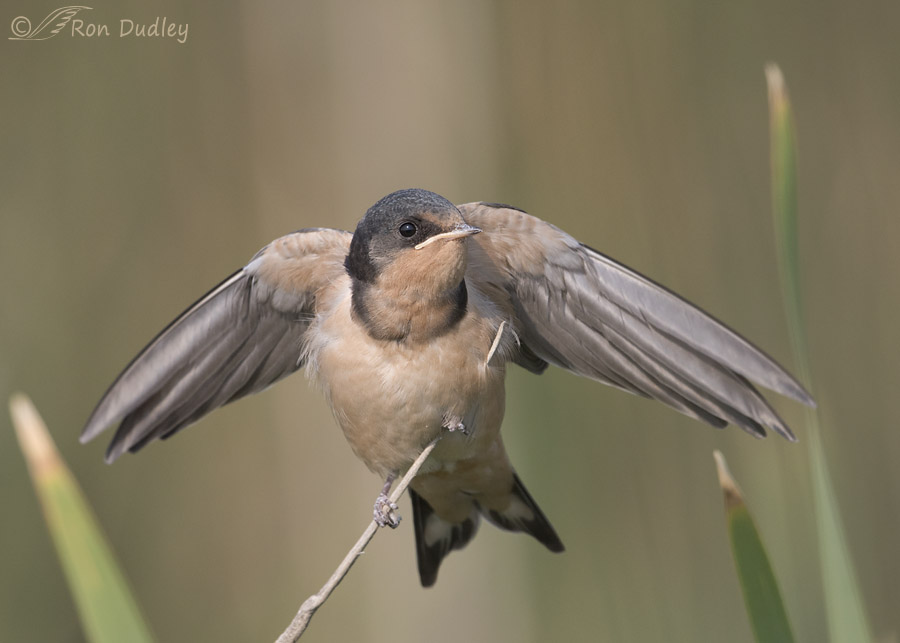
1/1600, f/7.1, ISO 640, Canon 7D Mark II, Canon EF500mm f/4L IS II USM +1.4 tc, not baited, set up or called in
Six days ago at Bear River MBR I photographed this fledgling Barn Swallow as it was being fed by its parents. Here it’s in a begging posture as it sees one of the adults approaching in the air. For some reason it was never fed while it was on this perch but as soon as it moved to another perch (following photos) the adults brought food to it repeatedly.
A variety of things can go wrong during the food transfer.
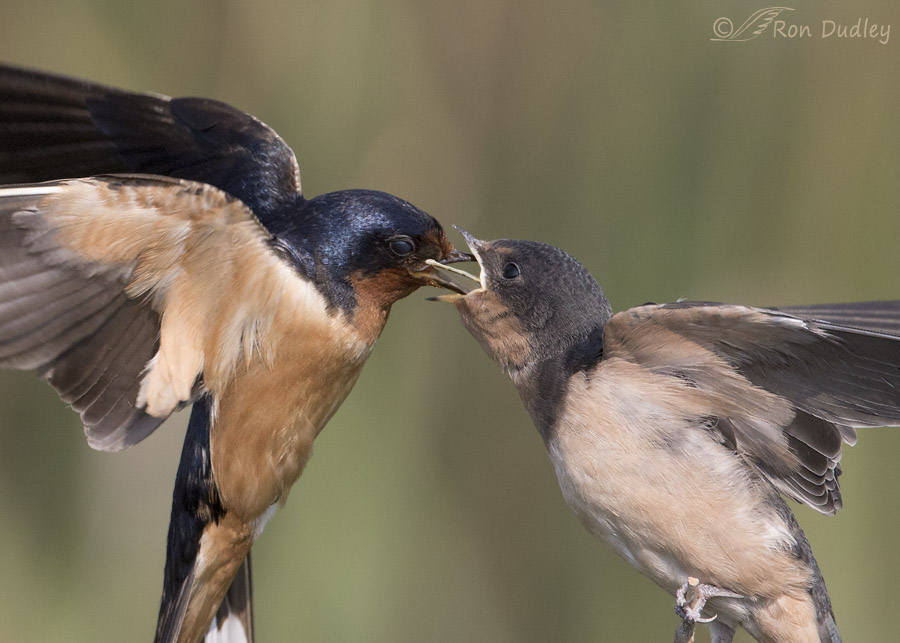
1/4000, f/7.1, ISO 800, Canon 7D Mark II, Canon EF500mm f/4L IS II USM +1.4 tc, not baited, set up or called in
This adult has included debris, a small twig, with the insect meal. This little mishap surprised me because I have to wonder how the adult picked up the twig if it (presumably) caught the insect in the air. I didn’t see (or photograph) how the younger bird dealt with the twig in its mouth.
Note: Sharp-eyed reader Christopher, in a comment below, pointed out that this is actually not a twig in the mouth of the fledgling – it’s the abdomen of a damselfly. If you squint you can actually see some of the wing of the insect between its abdomen and the lower mandible of the adult swallow. Thank you, Christopher!
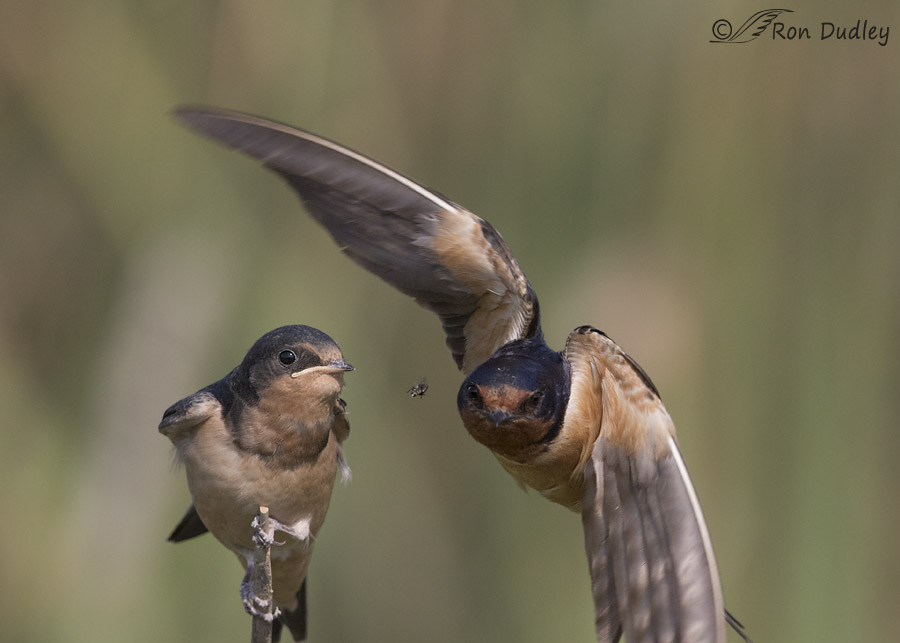
1/4000, f/7.1, ISO 800, Canon 7D Mark II, Canon EF500mm f/4L IS II USM, not baited, set up or called in
But another thing that can go wrong during the transfer is the loss of the insect meal (as I documented with this image in a post a few days ago). Because of the clumsiness and inexperience of the fledgling, the possibility that the insect may still be alive and the fact that the transfer takes place while the adult is in flight I suspect this potential loss of the meal must be a significant problem.
Here the insect is dropping to the ground between the two birds as the adult on the right begins to fly off.
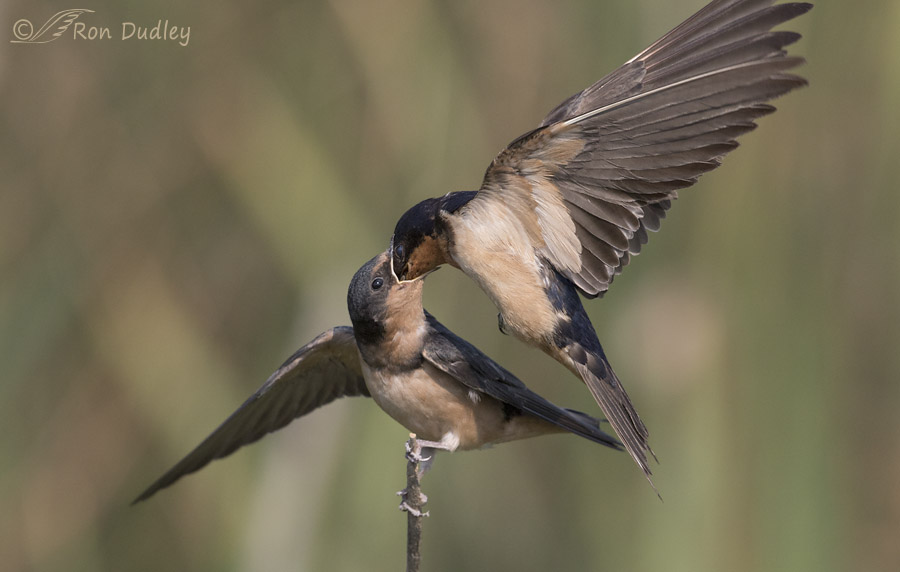
1/4000, f/7.1, ISO 800, Canon 7D Mark II, Canon EF500mm f/4L IS II USM, not baited, set up or called in
A variety of strategies are employed to prevent this food loss from happening. One of them is the instinct of the adult to place the insect deep down in the throat of the youngster.
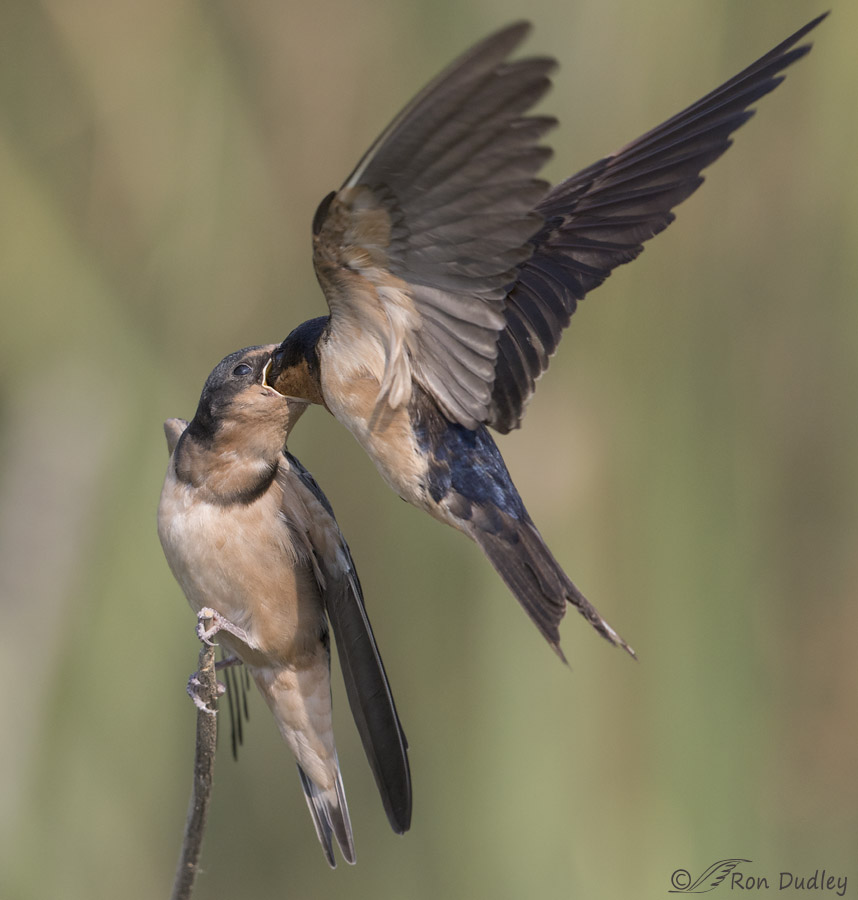
1/2500, f/6.3, ISO 640, Canon 7D Mark II, Canon EF500mm f/4L IS II USM, not baited, set up or called in
Time and again I photographed the adult with its head buried about a third of the way inside the wide open mouth of the fledgling. It seems logical that the further down the throat the food is placed the less likely it is to be lost by the clumsy youngster.
But there are other strategies designed to prevent food loss from happening.
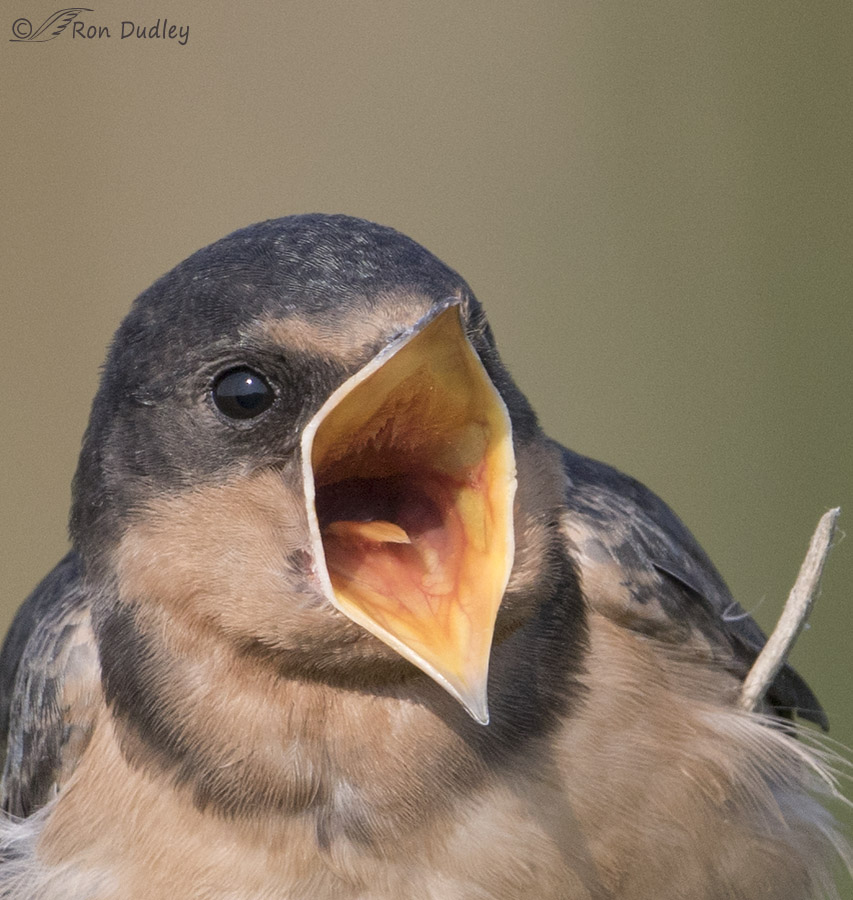
1/2000, f/7.1, ISO 640, Canon 7D Mark II, Canon EF500mm f/4L IS II USM +1.4 tc, not baited, set up or called in
The wide-open gape of a begging fledgling is a huge target that would be less easily missed due to its size. And the interior mouth lining of many baby birds is brightly colored (red in some species) so the target is also highly conspicuous.
And check out those backward-pointing, sharp projections on the back of the roof of the mouth. Once the meal is that far back (where it is usually placed by the adult) it would have a very difficult time going the “wrong way”, even if the insect meal was still alive and struggling. (I tried to look up the name for those projections but struck out…)
I’m sure there’s nothing new here for many of my readers (rehabbers especially) but I thought it was interesting to see both the behaviors and some of the adaptations up close in wild birds.
Ron


Ron, I also know those projections as choanal papillae. This post brought back so many memories of learning to feed baby birds at the hospital. I was terrified of aspirating them, and spent a lot of time watching parent birds feeding their young, so as to assure myself that I was doing it right.
Thanks very much, Ingrid. Sounds like the correct terminology might be a combination of the terms that April and I suggested.
Hi Ron,
Looking at the second photo, it looks to me that the adult is actually feeding the chick a damselfly (it looks like what you are calling a twig are the abdominal segments)
Of course, I was not there and did not see/photograph the transaction, so I could very well be wrong…
Oh – and GREAT photos!!!
Best,
Christopher
Good eye, Christopher. You’re absolutely correct! I blew the image up and there’s no question about it. And we can also see some of the wing of the damselfly between its abdomen and the lower mandible of the adult.
I’ll make a note in my text to acknowledge my error.
I believe the ” backward-pointing, sharp projections on the back of the roof of the mouth” are called choana.
April, I also encountered that term in my research but my understanding is that it refers to the slit in the hard palate, not the projections. It’s possible that those projections are referred to as papillae but I’ve been unable to confirm that.
I’m not saying you’re incorrect, just that I’m still unconvinced at this point. Thank you for your input!
Love it.
And would add another reason. The birds we hear begging for food are soooo noisy and soooo insistent that stuffing food so far down their throats might, just might, shut them up for a few seconds.
Ha, you may be right, Ec. It does quiet them down but not for very long.
These are outstanding photographs of the birds’ behavior! I particularly like the last image of the bird’s mouth! What an incredible shot! Thank you so much!
Thanks very much, Jane. That particular image is heavily cropped but I think it’s still very interesting.
Incredible behavioral shots Ron, thanks so much for sharing!
Charlotte
Thank you, Charlotte.
Jeeez! Fortunately for “our” lttle swallow, we didn’t try the head-head-the-mouth feeding approach…We used blunt tipped forceps to stuff that little glutton….in spite of conventional wisdom, it’s NOT always a good idea to “use your head!”…..a doctor neighbor/friend gave us a pair of his old forceps. The shots of that gaping maw brings back memories of what seemed like endless servitude…..A friend, an amazing “home schooled” by Mother Nature naturalist, recently found a baby mocking bird in the middle( literally) of the road. As no parents were visible but a cat was, John waited a while, then gave up his bird guard duties, took the baby home and raised it. When I heard this, my first reaction was, “Wow! Lucky Bird, lucky John!” I was jealous for about 60 seconds…Maybe 30. Then I remembered all those raucous, open beaks and the endless feedings….
Raising that little swallow seems to have left a lasting impression on you, Patty. I can imagine how tiresome it eventually became but I knew you’d stick to it until the little guy was raised.
Think of it this way. Perhaps that bird has had millions (literally) of descendants by now. What a difference you may have made!
Hmmmm………….
In looking at the size of the two different perches the fledgling choose, I wonder if the adult realized the first twig was not substantial enough to withstand the force of the feeding? Just a thought.
Could be, John.
One of the adults actually landed several times on the second perch below the juvenile but it never did so on the first perch.
Another great series. The last image is awesome. Very interesting behavior.
I hope you don’t mind I point it out but the shutter speed on the fifth image is not correct.(I wish we had a camera with that performance)
The reason I pay so much attention to your settings is because they are so different from the ones that I am used to.(I give you two exemples
120″,f/125,ISO 125 or 30″,f/90,ISO 100 it depends on the subject and the light that I am using.
“I hope you don’t mind I point it out but the shutter speed on the fifth image is not correct”
Ha, thanks for catching that typo, Jorge! I’ll blame it on not enough coffee at 5 AM. I’ve corrected it and I too wish I had a camera with that performance…
It’s neat to see the feeding behaviors close up – including the mouth interior. For me this is new, and very interesting. I guess I haven’t spent much time thinking about the difficulty of feeding babies like this one. Clearly a huge amount of effort goes into raising baby birds, even if they are not as complex to raise as human babies are.
“Clearly a huge amount of effort goes into raising baby birds”
Exactly, Susan – which makes some of the designs of nature even more fascinating. For example, precocial species (active and feeding themselves right after hatching) have much larger clutches than altricial species (naked and helpless at hatching).
Can you imagine pheasant or partridge parents having to bring food to up to 18 babies in the nest? An impossible task…
I can’t tell you the name of the reverse projections on the roof of the mouth, but, I believe the reason the adult bird pushes food so far into the mouth of the baby bird is to reach the esophagus opening that is on the right side of the mouth. As you know the esophagus is the entrance to the crop and the tongue is responsible for swallowing. The trachea is on the left side. So, I would gather that instinct for a parent bird is to get the food as close to the esophagus as possible. Just my 2 cents.
Great shots, wonderful clear image of the inside of the mouth of the Barn Swallow.
I agree, Dick. Makes me wonder how far some long-billed species push the food down the throat.
A Long-billed Curlew could push it from mouth to anus (cloacal opening) in one pass…
Have you a shot of a Long-billed Curlew feeding a chick? I would bet that it only goes to just above the opening of the esophagus in the chick. Instinct, DNA instructions, all have a roll to play.
No, I don’t have a shot like that and I’m sure you’re right when it comes to any long-billed species. And LB Curlew chicks leave the nest very soon after hatching and feed themselves.
I was just being facetious…
Sorry, didn’t mean to come off being too serious.
Don’t give it a second thought, Dick. You certainly didn’t “come off too serious” and I always, always appreciate your input!
I have a friend who is a veterinarian with a specialty in birds. I’ll ask her about this.
Thanks, Arwen. Gotta admit, I’m curious…
No answer on this so far. She’s an ER vet so her shifts are 24 hrs sometimes.